Mozambique. Bazaruto’s enchanting waters.
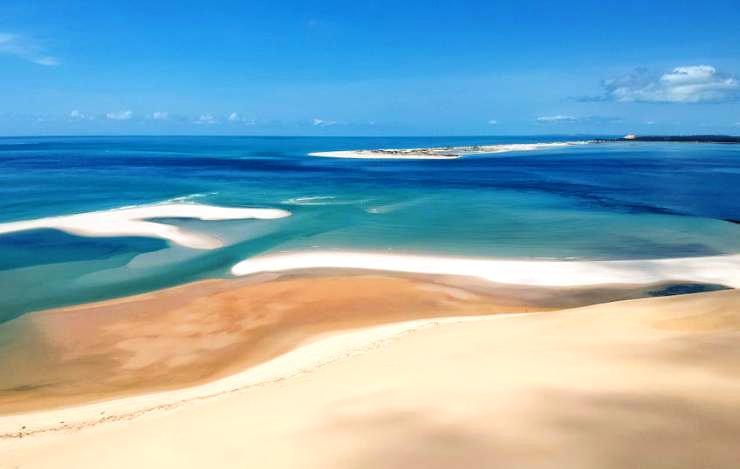
Off the southern coast of Mozambique, there lies an uncontaminated paradise of six islands surrounded by the turquoise waters of the Indian Ocean. The union of land and sea has its own special
magical alchemy
The habitat is uncontaminated, a place where land and ocean embrace according to the cycle of tides or the blowing of the wind, erasing frontiers, playing among the changing dunes, the weightless flights of the birds, the song of the whales and the darting of the dolphins.
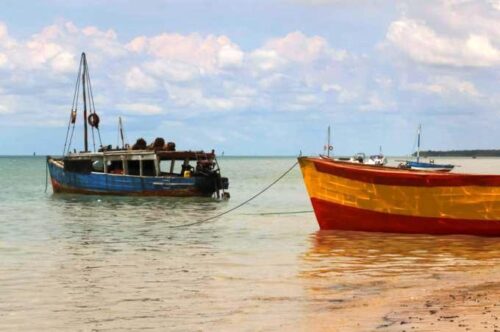
Old traditional sailing boats in the sea of Bazaruto Archipelago. 123rf.com
This magical place is the Bazaruto Archipelago, a handful of islands breaking through the turquoise waters of the Indian Ocean about twenty kilometres near the mainland city of Vilankulo.
The kingdom of the dugongs
The archipelago was once a peninsula until, twenty-five thousand years ago, the level of the oceans rose and the waters engulfed large parts of the land. Warmed by the hot Benguela current, the islands form an ideal environment for the growth of coral and the barrier rising off the eastern coast of the archipelago is home to abundant marine life. These waters are frequented by more than six hundred species of fish including sharks, manta rays and whale sharks; there is no shortage of cetaceans such as whales and five different species of dolphin.
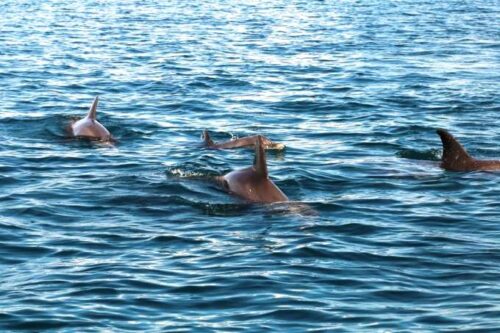
Group of dolphins swimming in the sea. 123rf.com
Winding gracefully despite their heavy armour, the marine tortoises seem to fly in the temperate waters; however, the most extraordinary and elusive creature in these islands is the rare dugong (Dugong dugong), a vegetarian siren that ‘grazes’ on the algae-covered seabed. The skies above the beaches and hinterland of the islands are inhabited by more than a hundred and sixty species of birds including herons, egrets, flamingos, peacocks, pelicans and even sea jays, fishing martins, cormorants, African jacanas, two species of bee-eaters and many storks, without counting the thousands of migratory Palearctic birds that populate the archipelago during the summer months.
A protected park
This exceptional biodiversity is spread across a territory with the most varied ecosystems ranging from savannahs to mangrove forests, from dense woods to sand-dunes, from a coral reef to swamps regularly flooded by the tides. All this natural richness induced the government of Mozambique, in the year 2000, to declare the archipelago a National Park and there is now a project of partnership with the international African Parks organisation for the joint management of the area.
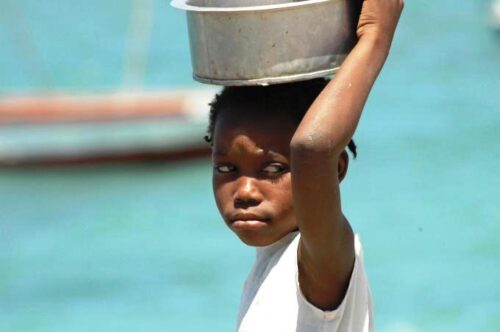
The history of human habitation on the islands is relatively recent: the Arabs established trading stations there in the XV century, while the Portuguese arrived only in the middle of the following century on the island of Santa Carolina, to trade in pearls and ambergris. The archipelago was spared the devastation of the civil war in the eighties thanks to its distance from the mainland, but a considerable number of refugees sought shelter there creating devastating pressure on the environment which fortunately ceased when the war ended (1992) and the fugitives could return to their villages.
Today, the archipelago has about three thousand inhabitants, mostly fishermen, spread over the five main islands and living in symbiosis with the environment.
Bays and lagoons
Bazaruto, elongated in form, is the largest of the islands of the archipelago. Almost forty kilometres long and seven wide, it features coasts of yellow sand facing the ocean, some of which, such as
that of Baia do Veleiro, consist of extremely large dunes
continually changed by the wind.
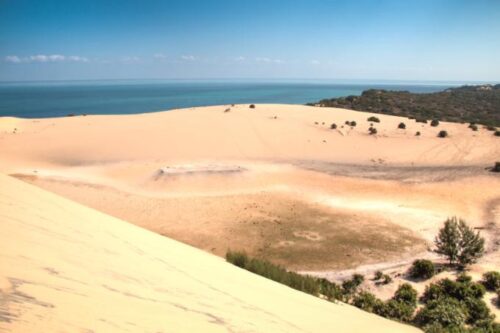
Dunes and forest near the beach on the Bazaruto Islands near Vilanculos. 123rf.com
At Ponta do Arena, on the extreme north-east of the island, there is the Baia dos Golfinhos (Dolphin Bay) where the Farrol do Bazaruto is located, a lighthouse built in 1913 by the Portuguese colonial authorities to indicate the island to vessels coming from the Indian Ocean. It is part of an array of lighthouses built between 1908 and 1931. During that period, along the coast of Mozambique, as many as thirty-two lighthouses were erected for the benefit of maritime traffic, twenty-three of which are still functioning.
The central spine of the island is punctuated by lagoons surrounded by reeds and palm groves inhabited by herons, cormorants, and pelicans. Occasionally, the nose and cold eyes of a crocodile break the surface of the water in search of prey.
Delicate pearls
To the south of Bazaruto rises the island of Benguerra, a little more than a quarter as long as its larger sister. Its enchanting beaches lapped by the tides, it is the pearl of the archipelago. A walk along the coast reveals the exoskeletons of the ‘sea-dollar’ (maritime invertebrates closely related to the sea-urchin); when the animal dies and decomposes on the sand, there remains only the white circular skeleton with a characteristically purple floral design at its centre.
The island, lashed by the wind, faces the turquoise ocean out of which, at low tide, there emerge sandbanks that appear like swift brush stokes marking the azure and green of the water; here, flocks of flamingos gather to feast on the crustaceans left high and dry by the tide.
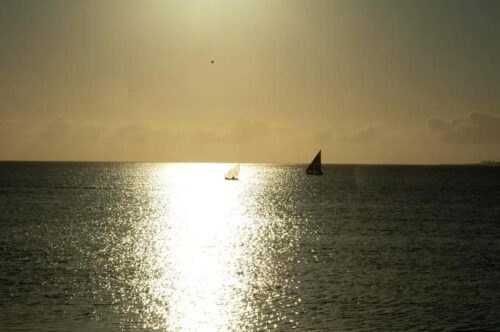
Magaruque and Bangué are the smaller sisters that emerge to the south of Benguerra: cloaked with the whitest of sand forming enchanting and deserted beaches that face stretches of coral reefs of rare beauty, they have sea-beds full of extraordinary fauna where dolphins play but a few metres from the shore.
Half way between the island of Bazaruto and the continental coast rises the island of Santa Carolina, a tiny, crescent-shaped island about three kilometres long and looking out over a splendid coral reef. This oceanic jewel was violated in the eighties by the construction of a luxury hotel that is now completely abandoned and in disrepair. The only redeeming aspect of this ruined edifice is represented by the project to dismantle it and use the rubble to construct an underwater barrier to protect the eastern coast of the island. If no measures were to be taken, the island of Santa Carolina, exposed to the violence of ocean currents, would eventually be broken in two by the erosive action of the waves. Furthermore, if the climate change now taking place is not halted, the entire paradise of Bazaruto could disappear forever under the waves of the ocean. (Open Photo: Bazaruto island. 123rf.com)
Gianni Bauce/Africa



